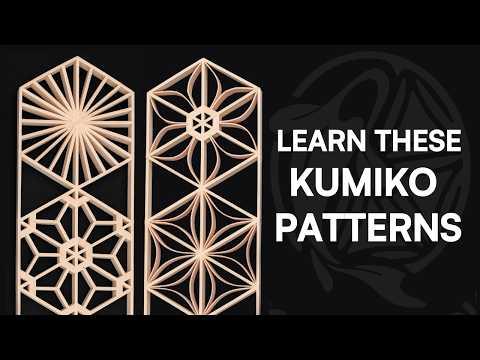Learn the Shippo Kumiko Pattern
by JT Woodworks in Workshop > Woodworking
3505 Views, 27 Favorites, 0 Comments
Learn the Shippo Kumiko Pattern


Kumiko is a traditional Japanese woodworking technique that involves creating intricate and precise geometric patterns using small, interlocking wooden pieces. There are hundreds of different patterns, each with their own unique design. This pattern is called shippo and features bend pieces of wood within a hexagonal grid. The grid construction is covered in detail in a youtube video and won't be explained here. This pattern and others are also covered in a youtube video in detail.
Plane the Strips



I usually make kumiko with basswood because it's easy to work with. I haven’t had much success with this bending basswood so I’ll be using cedar for pattern which also gives a nice contrast.
I’m planing these strips to be just under a 1/16” thick. The thinner the pieces, the easier they’ll bend.
Cut the Pieces to Size



Before we bend the pieces, we need to cut the angles on the ends.
These are cut with a 30º kumiko jig and just on one face. They aren’t flipped over to cut a point like in most other patterns.
With all those cut on one end, I adjust the jig and do the same to the other end. Trimming them to the correct length in the same process.
This is what the final piece looks like.
The final length of determined by the size of the grid and how drastic of a curve you want these pieces to have. This will take some experimenting to find what you think looks best.
Bend the Pieces





I put the pieces in a container and fill it with boiling water. It’s important that the water is extremely hot in order to get good results.
I cover the container to keep in the heat.
To help get consistent bends, I made this jig. It’s simply a rounded block of wood with a small area to hold the end of the pieces. The radius of the bending jig doesn't matter as long as its tighter than the final desired radius of the piece.
It’s important to go slow when bending these pieces as they can break very easily (and some will definitely break, so plan to make some extras). I’m bending it from one end, holding it for a few seconds, then flipping it around and bending from the opposite end to make sure the bend is even.
Make sure to bend them the right way! The angled face of the strip is facing down and is against the jig.
After bending one, I set it aside and repeat that process on a few more pieces.
Insert the Pieces




They get placed into the grid while they’re still wet. Three per open area.
If these pieces were a little longer, they would have a more drastic curve and the opposite if they were a bit shorter. Feel free to play around with the length of these pieces to see what look you like best.
The pieces are left in the grid to fully dry. Usually a couple hours depending on the environment.
At this point the pattern is complete but it's always a good idea to add some glue to make sure everything is locked in place.
Glue the Pieces


Once the pieces are fully dry, they’re removed and glued in place. Use a small brush to add glue in all the areas the pieces contact the grid. Insert the pieces just as before.
Finishing Touches


Once the glue dries, you can sand the panel to remove any inconsistencies between pieces and glue squeeze out. I like to use 220 grit or higher. The panel is very fragile so be gentle.
Congratulations! You made the shippo kumiko pattern! Remember to watch the video linked above for more details and patterns!